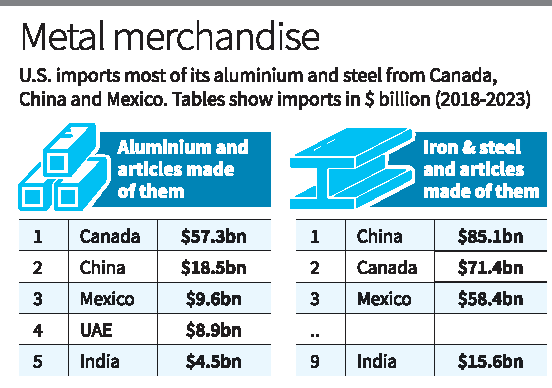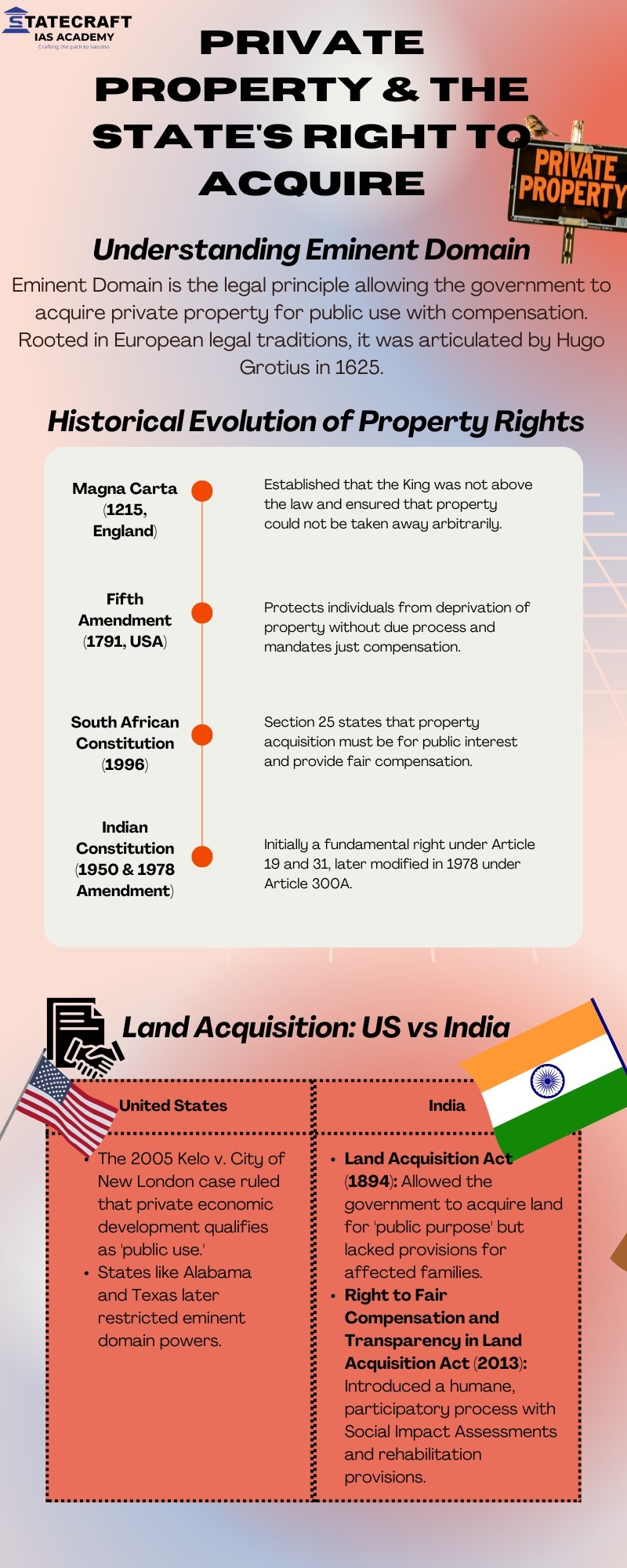1. Trump's Tariff Proposal on Steel and Aluminium Imports
Key Highlights
- S. Tariff Imposition:
- President Donald Trump announced 25% tariffs on all steel and aluminium imports, including from Canada, Mexico, and other countries.
- Expected to be implemented later in the week.
- Intended to protect the domestic steel industry.
- Reciprocal Tariffs:
- S. to impose import duties on goods from countries that have levied higher tariffs on American products.
- Example: Countries charging 130% duties while the U.S. charges nothing will face reciprocal tariffs.
- Economic & Political Context:
- Trump considers import taxes as a tool for negotiations on trade and immigration.
- Tariffs are also aimed at reducing the S. budget deficit.
Impact on Global Trade
- Major Exporters to the U.S.:
- Canada, China, and Mexico are among the top steel and aluminium suppliers to the U.S.
- S. imports most of its aluminium from Canada ($57.3B) and steel from China ($85.1B).
- India’s Position:
- India is a minor exporter compared to Canada and China.
- India exports $4.5B worth of aluminium and $15.6B worth of steel to the U.S.
- May lower duties on U.S. goods to maintain trade relations with the U.S.
- Geopolitical Implications:
- S. tariffs could escalate trade wars with allies and adversaries.
- Countries may seek retaliatory tariffs against the U.S.
Implications for bilateral and multilateral trade negotiations (e.g., WTO, NAFTA).
India-U.S. Trade Relations
- Upcoming Bilateral Talks:
- PM Narendra Modi to hold discussions with Trump on trade issues.
- India may offer tariff reductions on key U.S. goods to ease tensions.
- Specific mention of American pecan nuts as a potential item for reduced duties.
2. Governor’s Role in Bill Assent – SC Questions Tamil Nadu Governor’s Silence
Context
- The Supreme Court (SC) questioned the Tamil Nadu Governor for delaying assent to State Bills and not communicating objections to the State government.
- The Governor referred at least 10 Bills to the President without informing the State about his concerns.
Key Legal and Constitutional Aspects
Governor’s Powers Regarding State Bills (Article 200 & 201)
- As per Article 200 of the Constitution, the Governor has four options when a Bill is presented for assent:
- Give Assent – The Bill becomes law.
- Withhold Assent – The Bill is rejected.
- Return the Bill – Sent back to the State Legislature for reconsideration.
- Reserve the Bill for the President’s Consideration – Under Article 201, the President takes the final decision.
- SC’s Concerns:
- The Governor remained silent for years before suddenly referring the Bills to the President.
- Lack of communication about his objections deprived the State government of an opportunity to address concerns.
Arguments Presented in SC
- SC Observation (Justice J.B. Pardiwala):
- Criticized the Governor’s delay, stating:
- “He goes quiet for one or two years, then suddenly says I have referred them to the President.”
- Questioned why the Governor did not inform the State about his objections, which could have led to an agreement.
- Attorney General’s Argument (R. Venkataramani, for Governor R.N. Ravi):
- The Governor had earlier communicated objections to some Bills, particularly regarding the Vice-Chancellor appointment process in State universities.
- The Governor wanted the UGC Chairperson’s nominee in the search-cum-selection committee.
- SC Counterargument:
- If objections were raised earlier, the TN Assembly’s reconsideration of the Bills in November 2023 would not have been a mere formality.
- The State Assembly would have been aware of the Governor’s concerns.
Implications for Federalism & Governance
- Governor’s Role:
- The case raises concerns over the Governor’s discretionary powers and their impact on State governance.
- Delay in granting assent may affect State legislation and policy implementation.
- State Autonomy vs. Governor’s Authority:
- The SC’s observations highlight tensions between the elected State government and the centrally-appointed Governor.
- The judgment will set a precedent on the timely exercise of Governor’s powers.
3. Manipur Political Crisis & N. Biren Singh’s Resignation
Context
- Biren Singh resigned as the Chief Minister of Manipur under pressure from BJP dissidents and opposition parties.
- His tenure was marked by ethnic conflict between the Meitei and Kuki-Zo-Hmar communities.
- The resignation comes after months of instability, violence, and lack of reconciliation
Key Issues in Manipur Crisis
- Ethnic Conflict
- Violence between Meiteis & Kuki-Zo-Hmar communities has persisted for months.
- Singh was accused of fanning communal tensions by labeling Kukis as “infiltrators” from Myanmar and accusing them of harboring drug cartels.
- Failure to control armed groups—many looting police armories—led to a culture of impunity.
- Political Fallout
- Supreme Court involvement: Ordered forensic analysis of leaked audio tapes allegedly linking Singh to the conflict.
- Article 355 de facto applied: Central government took control of law and order without formal imposition.
- BJP’s electoral loss: The party lost both Lok Sabha seats in Manipur in the 2024 elections, reflecting public discontent.
- Displacement Crisis
- Over 60,000 people displaced due to violence.
- Lack of rehabilitation measures has worsened the humanitarian situation.
Implications for Governance & Federalism
- Role of Governor & Article 355
- Article 355 empowers the Union Government to intervene in a State’s affairs if there is a breakdown of law and order.
- This raises questions about the balance of power between State and Centre.
- Need for Reconciliation & Peace Talks
- Civil society engagement is crucial for conflict resolution.
- Restoring trust among ethnic groups and addressing grievances is key to peace.
- Political restructuring is necessary to ensure inclusive governance.
Way Forward
- New Leadership in Manipur: The BJP should appoint a CM who is not associated with past communal tensions.
- Rehabilitation & Resettlement: Address the humanitarian crisis by resettling displaced populations.
- Disarmament & Law Enforcement: Recover looted weapons and restore public confidence in security forces.
- Inclusive Dialogue: Involve all ethnic communities & civil society leaders in peace talks.
Federal Solutions: Explore innovative governance models like autonomy within the state system to address regional grievances.



